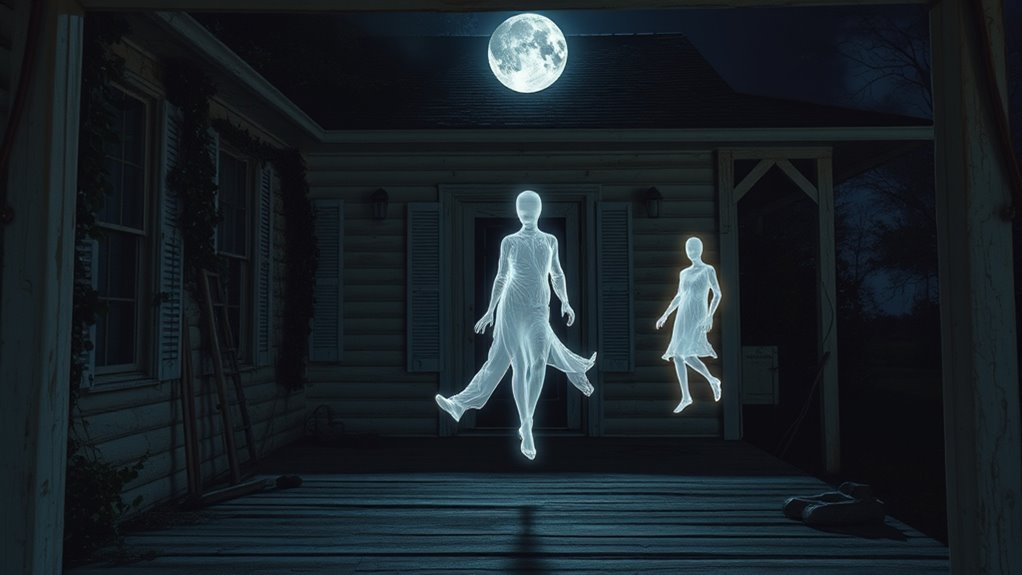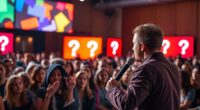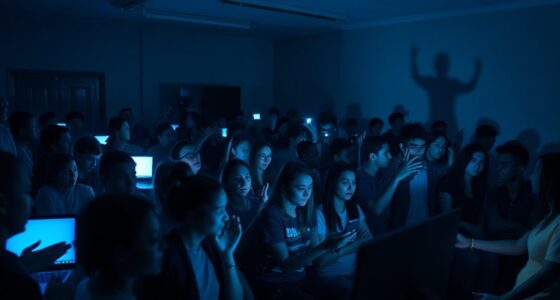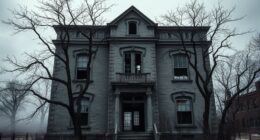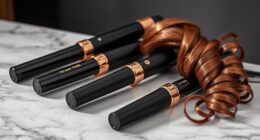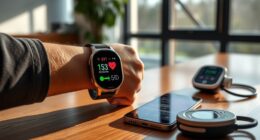When you send in ghost photos, we analyze the images carefully, considering their context, lighting, and signs of digital manipulation. We look for genuine shapes or shadows that could indicate paranormal activity while questioning unclear blurs or camera artifacts. Understanding how lenses, noise, or editing can create illusions helps us distinguish real spirits from optical tricks. Keep exploring, and you’ll uncover more about how experts separate eerie illusions from authentic ghostly evidence.
Key Takeaways
- Careful examination of photo details and context helps differentiate genuine paranormal images from illusions or manipulations.
- Recognizing common camera artifacts and digital noise is essential to assess the authenticity of ghost photos.
- Well-defined shapes and movement in images tend to be more credible, but still require scrutiny for possible editing.
- Background knowledge of the location’s paranormal history can support or challenge the image’s legitimacy.
- Critical analysis combined with curiosity allows for a balanced understanding of whether the image is spooky proof or optical illusion.
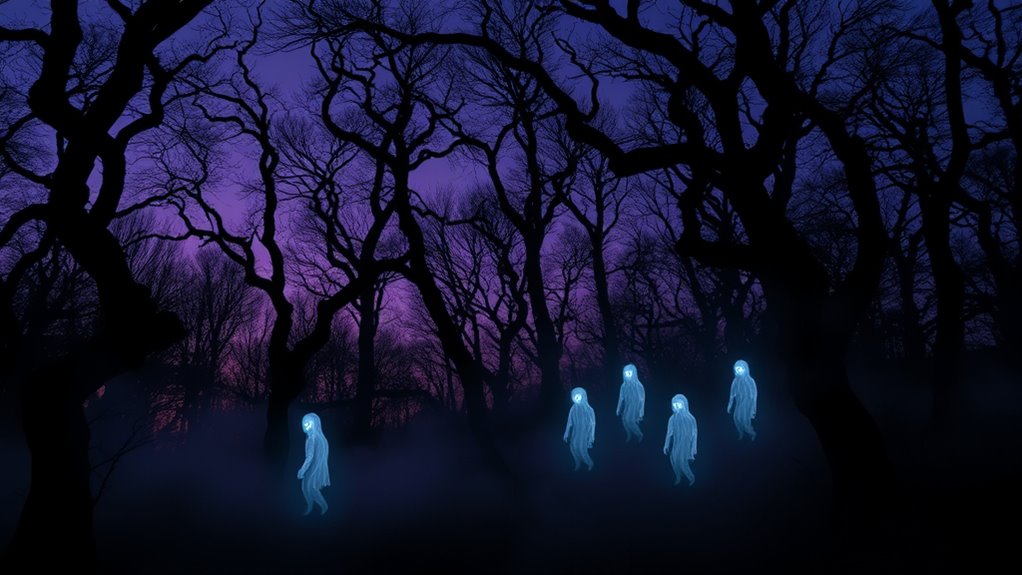
Many people are captivated by the mystery of ghost photos, especially when they come from everyday readers who believe they’ve captured supernatural entities. These photos spark curiosity and debate, often leaving you wondering whether what you’re seeing is real or just a trick of the light. When examining reader-submitted images, it’s essential to contemplate the role of paranormal photography, a genre dedicated to capturing evidence of ghostly apparitions. Paranormal photography aims to document supernatural activity with cameras, often revealing strange shapes or shadowy figures that seem to defy logical explanation. These images can be hauntingly compelling, but they also invite skepticism, prompting you to scrutinize every detail.
As you analyze these ghost photos, pay close attention to the context in which they were taken. Is the setting known for paranormal activity? Was the camera used in low-light conditions or with long exposures? Such factors can introduce anomalies like lens flares, reflections, or digital noise that might be mistaken for ghostly apparitions. Sometimes, what looks like a spirit is just a natural optical illusion or a camera artifact. Yet, other times, the images do seem to depict something inexplicable, fueling the belief that supernatural entities might be captured on film. This ambiguity is what makes paranormal photography both fascinating and controversial. Understanding the authenticity of these images is crucial in distinguishing genuine evidence from staged or accidental effects.
You should also examine the subject of the photo itself. Does the supposed ghostly apparition appear to have a distinct form or movement? Or is it a vague blur that could have been caused by camera shake? Sharp, well-defined shapes are more convincing, but even these can be manipulated or misinterpreted. Consider whether the photo has been edited or enhanced—digital manipulation can easily create convincing but false ghostly images. Authenticity becomes a key concern, and your skepticism helps ground your analysis, forcing you to differentiate between genuine paranormal evidence and cleverly staged images or camera errors. Additionally, understanding common camera artifacts can help you identify whether a photo is likely genuine or fabricated. Familiarity with digital noise and other visual distortions allows for better judgment of the images’ credibility. Being aware of photo editing techniques can further aid in spotting manipulated images that aim to deceive viewers. Ultimately, whether you’re convinced or not, the thrill of analyzing reader ghost photos lies in the exploration of the unknown. Paranormal photography offers a window into ghostly apparitions that seem to transcend our understanding, but it also demands careful scrutiny. By examining the details, deliberating the circumstances, and questioning the authenticity, you engage with the mystery on a deeper level. The truth behind these photos remains elusive, but your curiosity and critical eye keep the debate alive—whether you believe in spirits or simply enjoy the pursuit of ghostly evidence.
Frequently Asked Questions
How Do We Verify the Authenticity of Ghost Photos?
To verify ghost photos, you should look for signs of digital manipulation, like inconsistent shadows or irregular lighting, and examine photographic artifacts such as blurriness or strange reflections. Use photo analysis tools to detect edits and compare the image with others taken at the same time. Authentic ghost photos often avoid obvious signs of tampering, so scrutinize details carefully to determine if the image is genuine or altered.
What Common Mistakes Lead to Mistaken Ghost Images?
When examining mistaken ghost images, you often overlook common mistakes like misinterpreting photographic illusions or falling prey to pareidolia. Paranormal skepticism reminds you to question unusual shapes, as they could be just light reflections or shadows. You might also rely on poor photo quality or unintentional double exposures, which create false paranormal effects. Being aware of these pitfalls helps you distinguish between real ghostly images and everyday photographic errors.
Can Photo Editing Explain Some of These Ghost Sightings?
Yes, photo editing can definitely explain some ghost sightings. Digital manipulation allows you to alter images, creating eerie or mysterious effects. Filter effects can add ghostly glows or shadows, making ordinary photos look paranormal. When you see strange figures or lights, it might just be edited images or filters that deceive your eyes, rather than actual spirits. Always consider these editing techniques before jumping to supernatural conclusions.
Are Certain Camera Types More Prone to Capturing Ghost Images?
Coincidences often make certain camera types more prone to capturing ghost images. Cameras with smaller sensors tend to produce more sensor artifacts, which can resemble ghostly figures. Similarly, cameras prone to lens flare illusions may inadvertently create eerie shapes or lights. These factors combine to make some devices more likely to capture mysterious or paranormal-looking images, but it’s usually just optical quirks rather than actual spirits.
How Do Lighting Conditions Affect Ghost Photo Quality?
Lighting conditions greatly influence ghost photo quality by creating shadow illusions and lighting artifacts. When you take photos in dim or uneven light, shadows can appear more pronounced, leading to false ghost images. Bright, consistent lighting reduces these illusions, making genuine anomalies easier to identify. Poor lighting often enhances shadow illusions, so always aim for balanced illumination to minimize artifacts and improve the chances of capturing authentic paranormal phenomena.
Conclusion
So, next time you snap a ghostly photo, remember—you might just be capturing the most incredible apparition since the dawn of time. Your camera has the power to freeze moments that leave even seasoned skeptics trembling in awe. Whether real or imagined, these photos remind us that the supernatural is just a click away, waiting to turn your ordinary day into an extraordinary ghostly adventure. Keep those cameras ready—you never know when you’ll catch history’s most haunting image!
